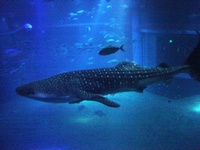
The whale shark, is a slow filter feeding shark that is the largest living fish species. This distinctively-marked shark is the only member of its genus Rhincodon and its family, Rhincodontidae (called Rhinodontes before 1984), which is grouped into the subclass Elasmobranchii in the class Chondrichthyes. The shark is found in tropical and warm oceans and lives in the open sea. The species is believed to have originated about 60 million years ago.
The name "whale shark" comes from the fish`s physiology; that is, a shark as large as a whale that shares a similar filter feeder eating mode.
Though it is often seen offshore, it has also been found closer to shore, entering lagoons or coral atolls, and near the mouths of estuaries and rivers. Its range is restricted to about ±30 ° latitude. It is found to a depth of 700 metres (2,300 ft)
The whale shark is a filter feeder—one of only three known filter feeding shark species (along with the basking shark and the megamouth shark). It feeds on phytoplankton, macro-algae, plankton, krill and small nektonic life, such as small squid or vertebrates. The many rows of teeth play no role in feeding; in fact, they are reduced in size in the whale shark. Instead, the shark sucks in a mouthful of water, closes its mouth and expels the water through its gills. During the slight delay between closing the mouth and opening the gill flaps, plankton is trapped against the dermal denticles which line its gill plates and pharynx. This fine sieve-like apparatus, which is a unique modification of the gill rakers, prevents the passage of anything but fluid out through the gills (anything above 2 to 3 mm in diameter is trapped). Any material caught in the filter between the gill bars is swallowed. Whale sharks have been observed "coughing" and it is presumed that this is a method of clearing a build up of food particles in the gill rakers.
This species, despite its enormous size, pose any significant danger to humans. It is a frequently cited example when educating the public about the popular misconceptions of all sharks as "man-eaters". They are actually quite gentle and can be playful with divers. There are unconfirmed reports of sharks laying still, upside down on the surface to allow divers to scrape parasites and other organisms from their bellys. Divers and snorkellers can swim with this giant fish without any risk apart from unintentionally being hit by the shark`s large tail fin.
The shark is often seen by divers in The Bay Islands in Honduras, Thailand, the Maldives, the Red Sea, Western Australia (Ningaloo Reef), Gladden Spit Marine Reserve in Belize, Tofo Beach in Mozambique, Sodwana Bay (Greater St. Lucia Wetland Park) in South Africa and at the Galapagos Islands.
The highest concentration of whale sharks to be found anywhere in the world is in the Philippines. From January to May, they congregate in the shallow coastal waters of Sorsogon province (at Donsol). Lucky divers have also come across whale sharks in the Seychelles and in Puerto Rico. Between December and September, they are well known to swim along the bay of La Paz in Mexico`s Baja California. Sometimes, they are accompanied by smaller fish, in particular, the remora. Recently, they have been seen in the vicinity of Tenggol Island, off the east coast of West Malaysia.